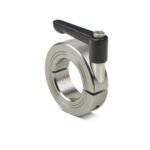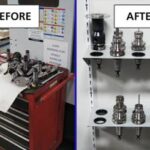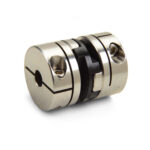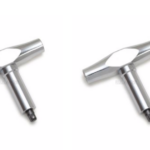 In this column, Bobby Watkins of Ruland Manufacturing explains the relationship misalignment and vibration.
In this column, Bobby Watkins of Ruland Manufacturing explains the relationship misalignment and vibration.
Not properly accounting for it can lead to premature coupling failure or system component failure. Clearly define your misalignment min and max early in the selection process. That choice can be of a great help in preventative maintenance. Misalignment again, introduces rpm limitations, vibration and noise. A good example of vibration and noise: beam couplings. Once the beam type coupling has failed and is unwound, it will not go back to its original form. Under misaligned conditions with a beam coupling, you can get resonance issue easily. The beams are bent, you’re turning at high RPM, and you can actually hear them.
When the vibration becomes excessive, you end up with a resonance issue. Usually with a beam coupling, if you’ve got a system that’s not tuned properly (for example, you haven’t tuned your stepper or tuned your servo motor system properly) the beam coupling can be sitting there in tension and actually vibrating due to the system just not being in tune.
I’ve had customers call and say, “you know my machine isn’t running. My beam coupling’s there but it’s vibrating.” It’s due to the system not being tuned properly so. Common causes of misalignment. Parts from different manufacturers can also be an issue. You’ve got a motor, you’ve got a motor bracket, or maybe the actuator is from another company. When mixing and matching components from different manufacturers, there can be inaccuracies in system assembly, mounts, et cetera… all can introduce misalignment. Many motor mounts that are used on actuators have pilot holes to slide your motor into. There’s a misbelief that as long as you put the motor in and bolt it down, that it’s in alignment and that’s not always the case. If those are clearance holes on that motor, on the motor bracket holes, you’re going to put the motor in and if the motor drops down in the holes and you bolt it down, you could have misalignment. Just because you’ve got a motor bracket, doesn’t mean that you don’t have to account for misalignment.
System motor movement during operation. Occasionally, the system running itself over time will put things out of alignment. System component wear. Things wear down. The input bearings on the motor and actuator wear out over time and that can cause the ball screw, which is locked into the end mount bearing, to actually drop a little bit. Again, it doesn’t take much to throw these systems off. Again, these are the types of misalignment: Angular misalignment is where the shafts are off at an angle. Parallel misalignment, that is the most common form of misalignment that people tend to deal with. And Complex misalignment is a combination of angular and parallel. Axial misalignment is an interesting type of misalignment and it’s one to watch out for. Axial misalignment is the shafts moving closer together or moving apart. All coupling types have a listed amount of misalignment in axial that they can handle. What causes max axial misalignment? Typically it’s high-speed motors and when the motor output shaft sits up at high speed, you get thermal expansion of that shaft and the coupling has to accommodate it. You want to make sure that if you have a high-speed motor at between 6,000 and 10,000 RPM, anything over 3,000 actually, you want to watch out for issues with axial misalignment due to thermal expansion of that motor shaft.
For more information, visit ruland.com.





Leave a Reply